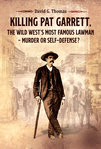


Learn about the death of Pat Garrett during a Culture Series presentation at the New Mexico Farm & Ranch Heritage Museum, 4100 Dripping Springs Road on Tuesday, Feb. 11. The presentation by local historian David Thomas is free and from 12:30 p.m. to 1:30 p.m. in the museum’s theater.Garrett, the Wild West’s most famous lawman – the man who killed Billy the Kid – was himself killed on leap-day, Feb. 29, 1908, on a barren stretch of road between his home ranch and Las Cruces.
Who killed him? Was it murder? Was it self-defense?
Award-winning author and historian David Thomas draws on newly discovered information and will discuss this fascinating story which is detailed in his new book, “Killing Pat Garrett: The Wild West’s Most Famous Lawman -- Murder or Self-Defense?”
The book’s awards include 2019 Best Book Awards Finalist, United States History; 2019 Best Indie Book Notable 100 Award Winner; 2019 Royal Dragonfly Book Award Winner, second place, Historical Non-Fiction.
Supplementing the text are 102 images, including six of Garrett and his family which have never been published before. It has been 50 years since a new photo of Garrett was published, and no photos of his children have ever been published.
Garrett’s life has been extensively researched, yet, the author was able to uncover an enormous amount of new information. Thomas had access to over 80 letters that Garrett wrote to his wife.
He discovered a multitude of new documents and details concerning Garrett’s killing, the events surrounding it and the personal life of the man who was placed on trial for killing Garrett.
Some of the new information Thomas found includes:
• The true actions of “Deacon Jim” Miller, a professional killer, who was in Las Cruces the day Garrett was killed.
• The place on the now abandoned old road to Las Cruces where Garrett was killed.
• Garrett’s original burial location.
• The sworn courtroom testimony of the only witness to Garrett’s killing.
• The policeman who provided the decisive evidence in the trial of the man accused of murdering Garrett.
• The location of Garrett’s Rock House and Home Ranches.
• New family details: Garrett had a four-month-old daughter the day he killed Billy the Kid. She died tragically at 15. Another daughter was blinded by a well-intended eye treatment; a son was paralyzed by childhood polio; and Pat Garrett, Jr., named after his father, lost his right leg to amputation at age 12.
Pat Garrett met two U.S. presidents: William McKinley and Theodore Roosevelt. President Roosevelt he met five times, three times in the White House, brought the law to hardened gunmen, oversaw hangings. His national fame was so extensive the day he died that newspapers from the East to the West Coast only had to write “Pat Garrett” for readers to know to whom they were referring.
Garrett also had devastating lows. He experienced heartbreaking family tragedy. He was blocked for re-appointment as El Paso customs collector by unjustified personal animus. He was pursued ruthlessly for a loan that he had co-signed as a favor for a friend. He had his ranches and livestock confiscated and sold on the Las Cruces public square.
Despite his reputation as a gunman, when faced with public humiliation, Garrett responded with commendable dignity. Queried after losing his custom collector job, he reportedly replied: “I simply take my medicine.”
Thomas said this book is written so the reader can experience Garrett’s life as he did, as it happened, event by event.